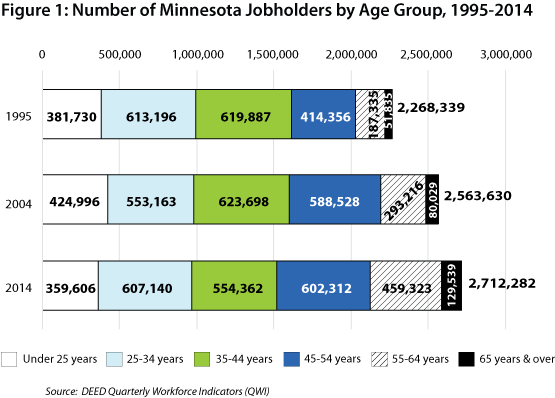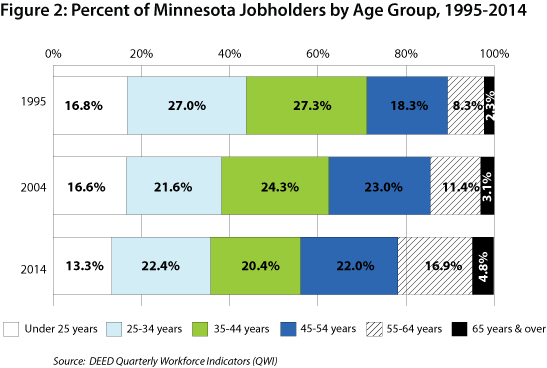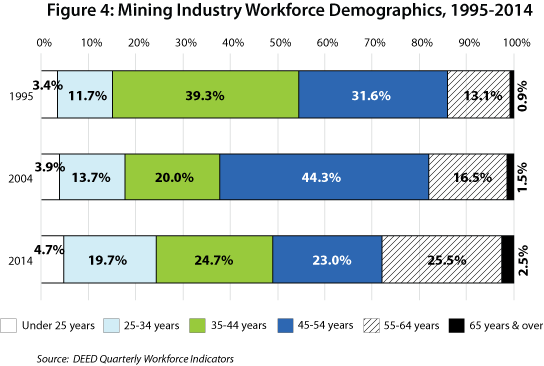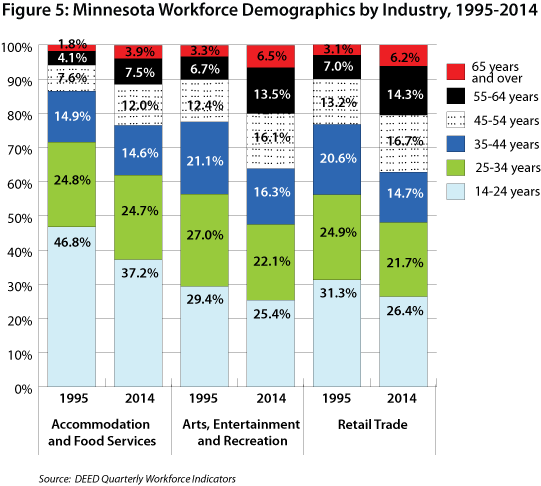by Cameron Macht
November 2015
Minnesota's economy has seen strong growth over the past 20 years, with employment growing from just under 2.3 million jobs in 1995 to more than 2.7 million jobs in 2014, a 20 percent increase. This included a gain of more than 295,000 new jobs from 1995 to 2004, then about 150,000 more jobs from 2004 to 2014, despite the Great Recession.
As the labor force has grown to fill the available jobs and meet the needs of businesses, Minnesota's workforce has undergone a seismic shift in demographic composition. The vast majority of jobs - 65 percent - are still filled by workers in their prime working years, between 25 and 54 years of age. But the number and percentage of jobs filled by workers under 25 years of age has fallen, while the number and percent of jobs held by workers aged 55 years and over has risen quickly (see Figure 1 and Figure 2).


According to data from DEED's Quarterly Workforce Indicators program, the number of jobs filled by workers from 25 to 54 years of age rose from 1,647,439 workers in 1995 to 1,753,267 workers in 2014. However, the percentage of jobs held by these workers fell from 72.6 percent in 1995 to 65 percent in 2014.
Likewise, the percent of jobs filled by the youngest workers was also dropping over time, from 16.8 percent of total jobs in 1995 to 13.3 percent in 2014. In contrast, the number of jobs retained by workers aged 55 years and over increased from 239,170 in 1995 to 588,862 in 2014, up from 10.5 percent to 21.7 percent of total jobs over the course of two decades.
This means that more than one in every five jobs in Minnesota is now held by workers who are within 10 years of - or already at - retirement age. While these older workers have remained in the labor force longer to fill jobs over the past 10 years, that growth may slow in the next 10 years.
Every industry saw an increase in the number and percentage of older workers during the past 20 years, with 16 of the 20 major industries in the state doubling the number of jobs worked by people aged 55 years and over from 1995 to 2014.
Perhaps surprisingly, the highest concentration and the largest increase occurred in Transportation and Warehousing, where just over 30 percent of the jobs were filled by workers aged 55 years and over in 2014. The aging of the Transportation and Warehousing industry happened especially fast - it climbed up from the eighth highest percentage of workers aged 55 years and over in 1995 to the highest in 2014. That included 8.8 percent of jobs held by workers who were already 65 years or over, meaning nearly one in every 11 Transportation and Warehousing workers could retire at any time (see Figure 3).

The aging trend is perhaps more well-known and documented in the Educational Services industry, where over 28 percent of jobs are held by workers aged 55 years and over. It's a long-standing issue for schools. The state's Educational Services industry had the highest percentage of older workers in both 1995 and 2004, which led the state legislature to require a bi-annual report on teacher supply and demand.
The 2015 Minnesota Teacher Supply and Demand report showed that "attrition was relatively high between the 2012-13 and 2013-14 school years," yet "enrollments are holding at the same level as in 2012" and "fewer districts are reducing their teacher workforce" which would "suggest greater demand." 1.
The data in the report show that over 25 percent of teachers leaving between 2008 and 2013 retired, although retirements hit different regions and license areas harder than others. In particular, the Northwest and Southwest regions saw the biggest impact from teacher retirements in the state, while elementary and special education were the license areas most impacted.2.
The industry with the highest percent of workers aged 55 to 64 years - who are less than 10 years from retirement - was Mining. The percent of mining jobs held by 55 to 64 year olds increased 12.3 percent over the past 20 years, and the age cohort now comprises over one-fourth of the Mining workforce. This is a big issue for the Mining industry, since data show it does not rely on workers aged 65 years and over. However, the Mining industry was also the only industry that saw an increase in the percentage of workers under 25 years over the past 20 years. Consequently, the mines saw a big drop in the middle age workforce, where 70 percent of Mining jobs were held by workers between 35 and 54 years of age in 1995, down to just 47.7 percent in 2014 (see Figure 4).

The Utilities industry was in the same boat as Mining, with one-fourth of the jobs held by 55 to 64 year old workers, and just 2.5 percent of jobs held by workers aged 65 years and over. The increase in 55 to 64 year olds happened faster in Utilities, rising from 11.6 percent in 1995 to 25.3 percent in 2014, while the percent of 45 to 54 year olds strangely held relatively steady at about 30 percent. In Utilities the big drop occurred in 35 to 44 year olds.
The number of workers aged 55 years and over in Public Administration nearly tripled over the past 20 years, and now more than one in four jobs are held by workers that are within 10 years of or already at retirement age. As skilled and long-serving workers start to transition out of these jobs, succession planning and knowledge transfer are two major components of Minnesota's Workforce Planning strategy.3.
Even the industries that tend to rely on a younger workforce were seeing a shift in their workforce composition over time. The Accommodation and Food Services, Retail Trade, and Arts, Entertainment, and Recreation industries all have more than 25 percent of their jobs taken by workers from 14 to 24 years of age.
In both Retail Trade and Arts, Entertainment, and Recreation the percentage of jobs retained by workers aged 55 years and over jumped from 10 percent in 1995 to 20 percent in 2014, including more than 6 percent that were filled by workers aged 65 years and over. The percent of older workers grew from 5.9 percent to 11.4 percent in Accommodation and Food Services, although that was still the lowest reliance on older workers of all industries in the state (see Figure 5).

As the state's labor market growth slows and the workforce continues aging, businesses in all industries will need to shift their long-term planning to include older workers who may only be available for shorter terms. Several industries already have over one-fourth of their jobs held by workers at or near retirement age, and every industry's workforce composition aged rapidly over the past two decades.
1. 2015 Minnesota Teacher Supply and Demand. education.state.mn.us/mdeprod/idcplg?IdcService=GET_FILE&dDocName=059257&RevisionSelectionMethod=latestReleased&Rendition=primary
2. Ibid